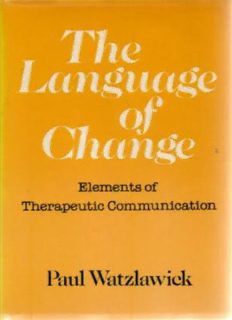
The Language of Change: Elements of Therapeutic Communication PDF
Preview The Language of Change: Elements of Therapeutic Communication
Watzlawick* Paul* The language of change : elements of therapeutic communication / Paul Watzlawick* ---- New York : Basic Booksf c 1978. xif 172 p* • i ll* y 22 cm* Bibliography: p* 161—166* Includes index* #5779 Brodart $12*50* ISBN 0-465-03792-5 1* Psychotherapy* 2* Interpersonal communication* 3* Left and right (Psychology) I* T itle The Language of Change BOOKS BY PAUL WATZLAWICK An Anthology of Human Communication: Text and Tape Pragmatics of Human Communication: A Study of Interactional Patterns, Pathologies and Paradoxes (with Janet H. Beavin and Don D. Jackson) Change: Principles of Problem Formation and Problem Resolution (with John H. Weakland and Richard Fisch) How Real Is Real? The Interactional View: Studies at the Mental Research Institute, Palo Alto, 1965—74 (edited and with a commentary by Paul Watzlawick and John H. Weakland) TECH Elements of Therapeutic Communication PAUL WATZLAWICK MENTAL RESEARCH INSTITUTE PALO ALTO, CALIFORNIA BASIC BOOKS, INC., PUBLISHERS NEW YORK ACKNOWLEDGMENTS The cartoon on page 53 is reprinted with the permission of Magi Wechsler, the artist. The cartoon originally appeared in the Neue Ziircher Zeitung (NZZ) 49/70. The advertisement on page 82 is reprinted courtesy of the Phillips-Van Heusen Corporation. The cartoon on page 85 is reprinted by permission of the Newspaper Enterprise Association. The excerpt on page 14 from “An Imperial Message” by Franz Kafka appears in Parables and Paradoxes. Copyright © 1946, 1947, 1948, 1953, 1954, 1958 by Schocken Books Inc. Copyright © renewed 1974 by Schocken Books Inc. Reprinted by permission. The author gratefully acknowledges permission to reprint portions of the fol lowing material. Max Frisch, The Fire Raisers, in Three Plays, trans. Michael Bullock (Lon don: Methuen & Co., 1962). Reprinted by permission of Hill and Wang, Inc. Hugo von Hofmannsthal, The Difficult Man, in Plays and Libretti, Bollin- gen Series, vol. 33, no. 3 (New York: Pantheon Books, 1963), pp. 712-713. Copyright © 1963 by Princeton University Press. Jay Haley, Uncommon Therapy: The Psychiatric Techniques of Milton H. Erickson, M.D. (New York: W. W. Norton, 1973). Reprinted by permission of W. W. Norton, Inc. Copyright © 1963 by Jay Haley. Milton Erickson, “The Use of Symptoms as an Integral Part of Hypno therapy,” American fournal of Clinical Hypnosis 8 (1965): 57-65. Reprinted by permission. Milton Erickson and L. Rossi, “Varieties of Double Bind,” American four nal of Clinical Hypnosis 17 (1975): 143—57. Reprinted by permission. Library of Congress Cataloging in Publication Data Watzlawick, Paul. The language of change. Bibliography: p. 161. Includes index. 1. Psychotherapy. 2. Interpersonal communica tion. 3. Left and right (Psychology) 1. Title. RC480. 5.W34 616.8*914 77-20416 ISBN: 0-465-03792-3 Copyright © 1978 by Paul Watzlawick Printed in the United States of America DESIGNED BY VINCENT TORRE IO 9 8 7 6 5 To Dr. Milton H. Erickson Who Heals With Words CONTENTS PREFACE IX 1. Overview 3 2. Our Two Languages x3 Our Two Brains 3- 19 Experimental Evidence 28 4 - World Images 40 5- 6. Right-Hemispheric Language Patterns 48 Condensations 49 Figurative Language 56 Pars pro toto 69 Aphorisms 73 Ambiguities, Puns, Allusions 78 7. Blocking the Left Hemisphere 91 11 est interdit d’interdire 99 Symptom Prescriptions 101 Symptom Displacements 106 The Illusion of Alternatives 108 Reframing ji8 8. Injunctive Language—Behavior Prescriptions 127 9. Anything, Except THAT 138 Speaking the Patient’s “Language” 139 Utilizing the Patient’s Resistance 144 Preempting 150 Vll Therapeutic Rituals Conclusion WORKS CITED INDEX PREFACE Similia similibus curantur. (Like cures like) The thesis of this book is simple; its practical application is not. Monsieur Jourdain, the hero of Moliere’s comedy, he Bourgeois Gentilhomme, wants to send his beloved a billet-doux and enlists the help of his preceptor for this task. The latter wants to know if it should be composed in verse or in prose. Monsieur Jourdain at first rejects both alternatives. Upon being informed that there is no third possibility, he cannot get over his astonish ment that for forty years he should have been speaking prose without knowing it. This book wants to show that very much the same holds true for the language of psychotherapy. Not only were the ancient rhetoricians fully aware of many of its essential properties, but many other characteristics have for a considerable time been the object of detailed studies in the most diverse areas of human ex perience—in childhood, language formation, fiction, wit, dream, ecstasy, intoxication, and delusion. But what thereby emerges from realms which on account of their sinister strangeness are ascribed to the unconscious, dark side of the soul is, in clinical dialogue, habitually translated into the supposedly IX
Description: